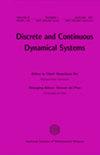On the probability of positive finite-time Lyapunov exponents on strange nonchaotic attractors
IF 1.1
3区 数学
Q1 MATHEMATICS
引用次数: 1
Abstract
We study strange non-chaotic attractors in a class of quasiperiodically forced monotone interval maps known as pinched skew products. We prove that the probability of positive time-$ N $ Lyapunov exponents—with respect to the unique physical measure on the attractor—decays exponentially as $ N\to \infty $. The motivation for this work comes from the study of finite-time Lyapunov exponents as possible early-warning signals of critical transitions in the context of forced dynamics.奇异非混沌吸引子上有限时间Lyapunov正指数的概率
我们研究了一类被称为紧缩斜积的拟周期强迫单调区间映射中的奇异非混沌吸引子。我们证明了相对于吸引子上的唯一物理测度的正时间- $ N $ Lyapunov指数的概率呈指数衰减为$ N\to \infty $。这项工作的动机来自有限时间李雅普诺夫指数的研究,作为强迫动力学背景下关键转变的可能预警信号。
本文章由计算机程序翻译,如有差异,请以英文原文为准。
求助全文
约1分钟内获得全文
求助全文
来源期刊
CiteScore
2.50
自引率
0.00%
发文量
175
审稿时长
6 months
期刊介绍:
DCDS, series A includes peer-reviewed original papers and invited expository papers on the theory and methods of analysis, differential equations and dynamical systems. This journal is committed to recording important new results in its field and maintains the highest standards of innovation and quality. To be published in this journal, an original paper must be correct, new, nontrivial and of interest to a substantial number of readers.

 求助内容:
求助内容: 应助结果提醒方式:
应助结果提醒方式:


